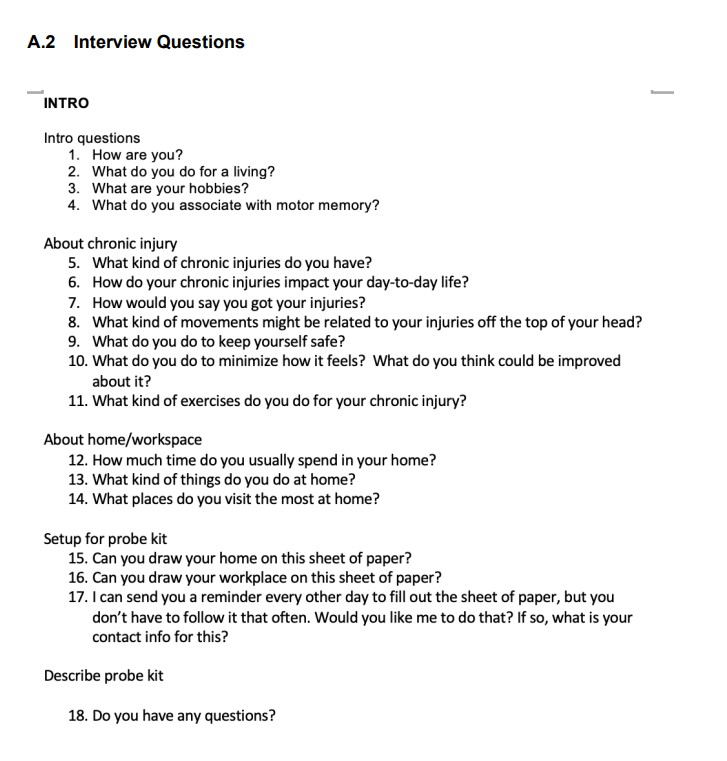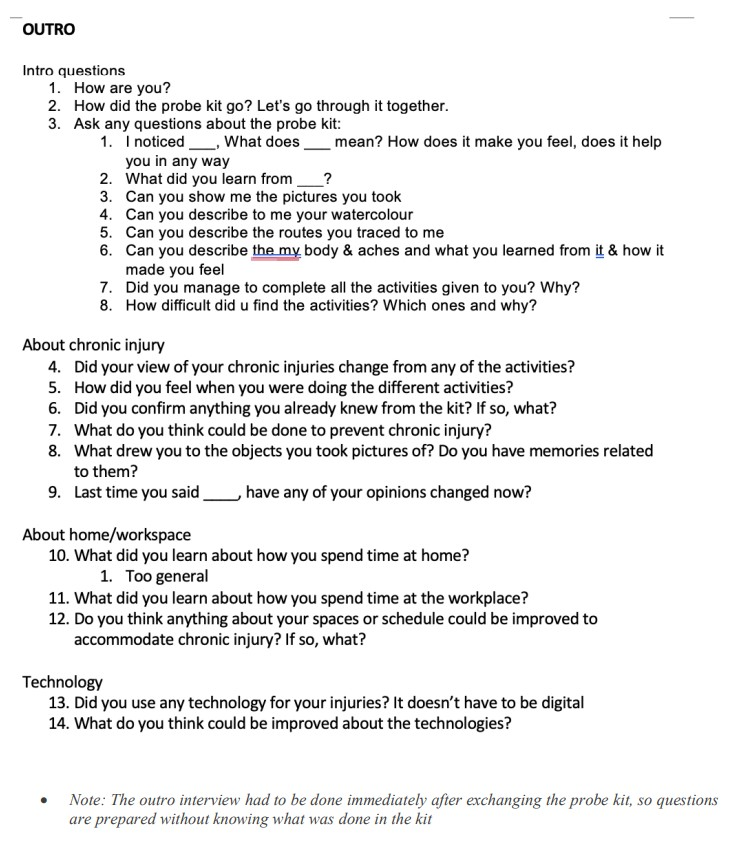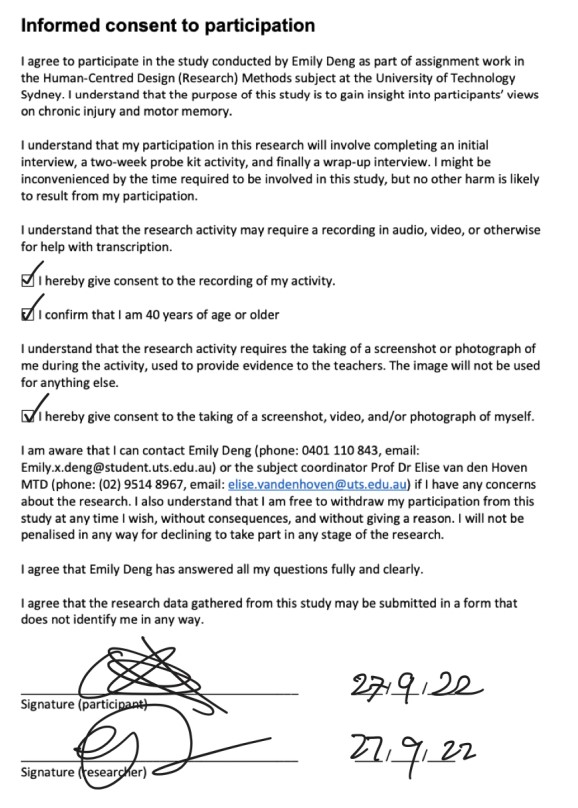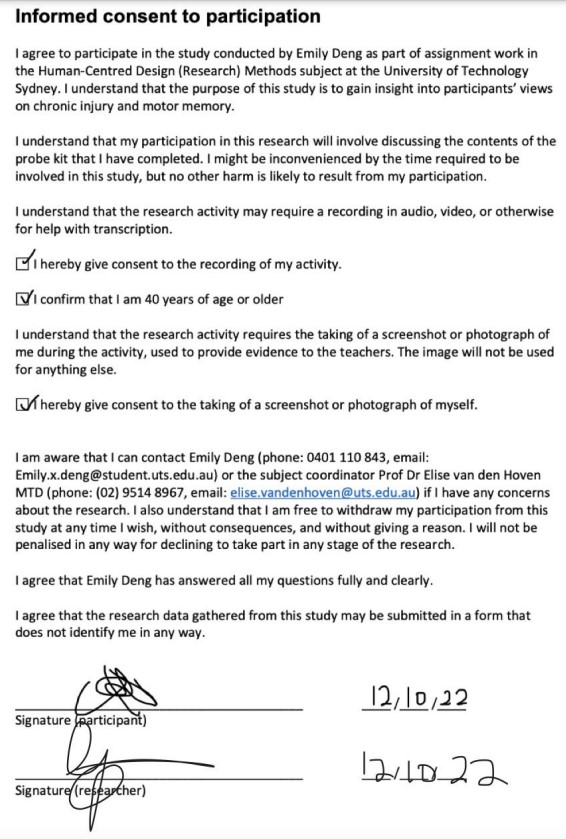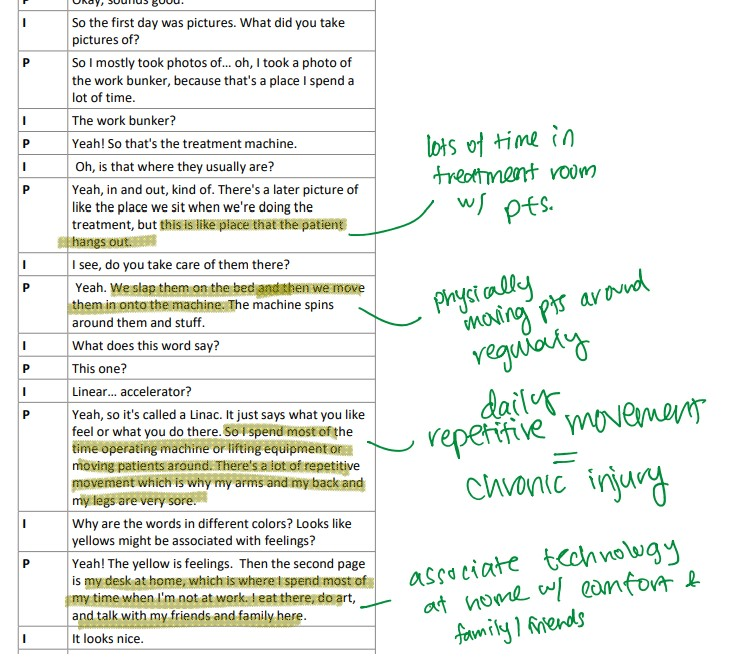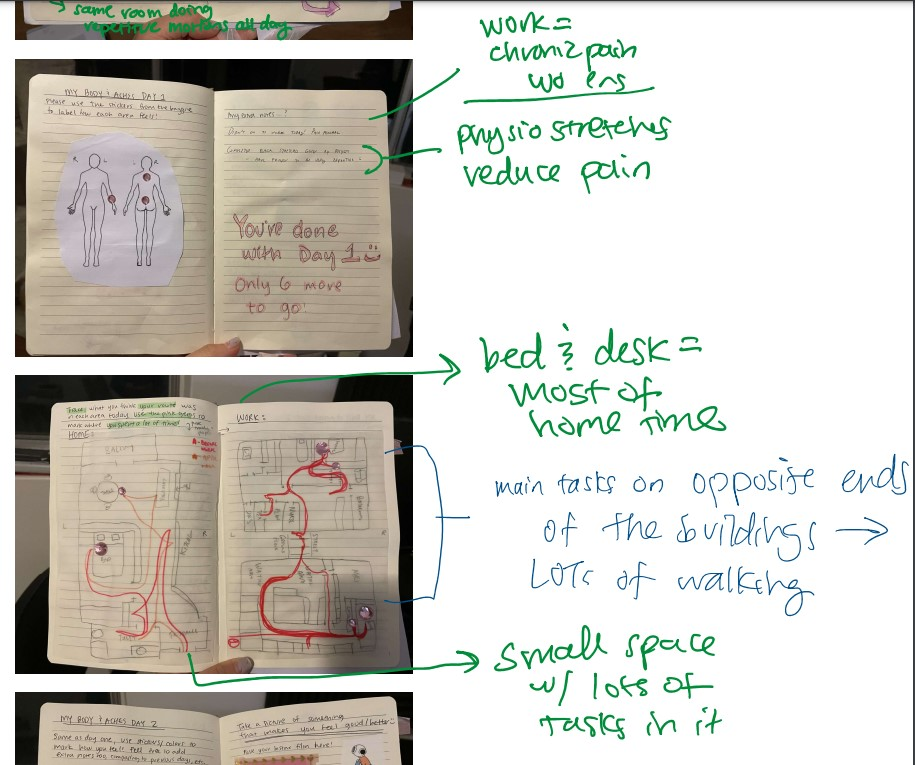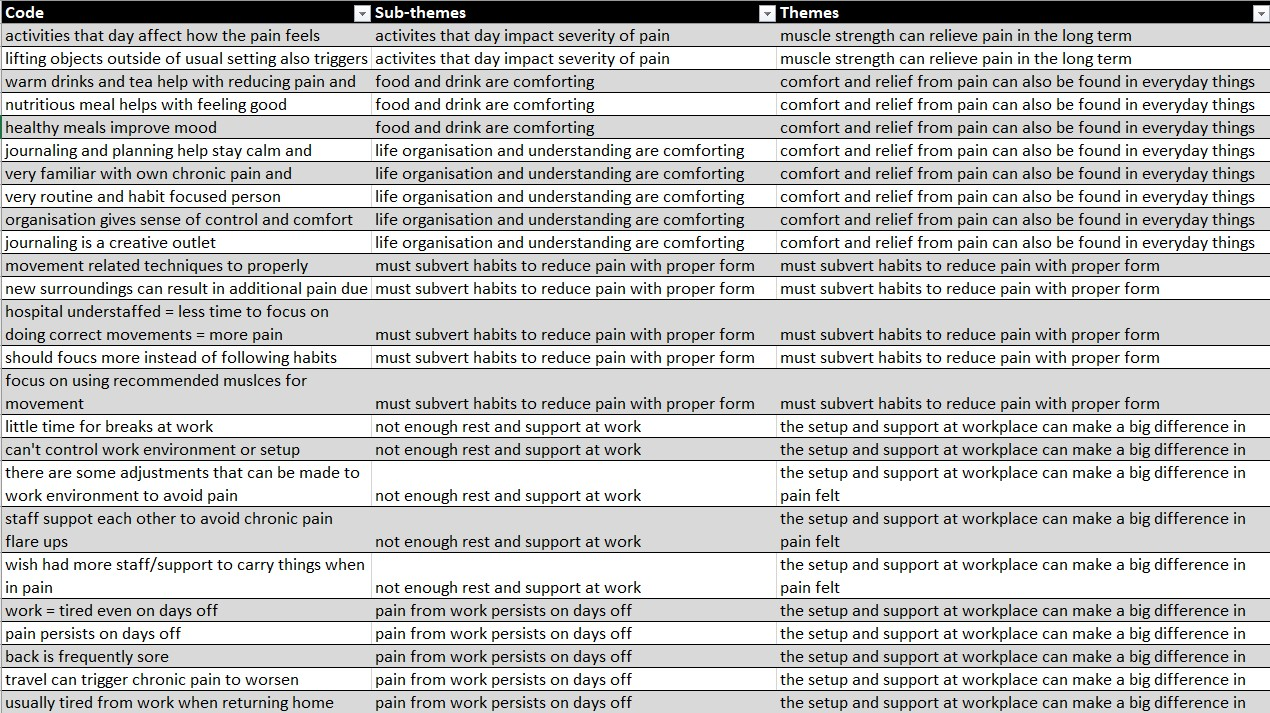Probe Kit Design Project
The Aches Album was done for a probe kit design and analysis assignment through the Human-Centred Research Design Methods course at the University of Technology Sydney.
My role was to design the probe kit and ultimately analyse the results and interviews from the kit in action.
This was done over seven weeks.
My final mark for this course was an HD.
“The thoroughness of the whole probing process was excellent, with a series of engaging and effective activities to explore your topic with the help of your participant. [..] The same can be said about your analysis process; both the coding and thematic analysis show a very good understanding of the method and how to process the data to try and answer your research questions.”
Assignment Feedback from Dr. Alejandra Mery Keitel
Problem
According to the Australian Institute of Health and Welfare, 1.6 million Australians suffered from chronic pain in 2016. Furthermore, it has been found that chronic pain often has comorbidities, including insomnia, depression, and fatigue (Gardiner, 2020).
Chronic pain greatly impacts the quality of life for people worldwide. The study aims to address the following questions:
- “How can we disrupt our motor memory to prevent or reduce chronic injury?”
- “How can we improve the home lives of people with chronic injuries?”
Solution
After conducting a probing study, the thematic analysis found that motor memory can be disrupted through posture tools and muscle building to prevent chronic pain.
Furthermore, peoples’ home and work lives could be improved by adjusting the setup of their space to account for their pain.
With the increased acceptance of technologies being used for patient care, there are several opportunities for accessible and educational products and designs that can decrease the prevalence of chronic pain.
1. Research
In this phase, I read through academic articles and looked for existing products that may address chronic injury prevention and reduction.
While several studies exist, few focus on its relationship with motor memory, and even fewer are done qualitatively at the depth of a probe study.
In 2020, Paula Gardiner published a study about an electronic health toolkit that was tested on patients with chronic pain to determine whether the product would be a more accessible way for people to receive chronic pain relief. She found that interventions through technology were increasing due to several factors, such as convenience for patients and increased social acceptability of them.
The Journal of Engineering also published a newspaper article about a product called PostureKeeper, a networked device to improve the posture of those working at two desks (2018). However, this product never quite reached the mainstream.
2. Probe Kit Design
To perform this research, I created the Aches Album probe kit and recruited a participant with chronic pain to complete it over two weeks.
The probe kit was split into seven days’ worth of activities that asked the participant to reflect on their pain and document their day and how they felt.
A video showcasing the kit’s contents before and after completion can be seen to the right.
Performing a probing study allowed for an in-depth and personal view of the participant’s daily life, the patterns of their chronic pain, and their home and work setups that influence it. The colours and photos for the kit were selected based on the participant’s preferences.
3. Interview Process
I performed two semi-structured interviews with the participant, one before and one after she completed the kit. The interview scripts and associated consent forms can be found below.
I chose to do semi-structured interviews because the topic was quite personal, and this structure made room for casual, comfortable conversation and follow-up questions.
If I were to redo this in the future, I would prefer to review the probe kit in detail before writing questions for the outro interview. I believe the interview outcome could be improved even if I took a few brief minutes to flip through and make notes before interviewing the participant again.
4. Thematic Analysis
5. Results
- Pain can be related to someone’s identity and place in life
“So the way that my body’s built, my ankles are hyper-flexible. And my arms are bent funny. So I’m just bound to have chronic pain. So I was destined.”
- Proper setup and amount of support at a person’s workplace can make a big difference in reducing or exacerbating chronic pain
“Work is a little chaotic because we work across both sides of the road. So it’s just a lot of running around. I guess in short, a lot of it is walking from the treatment room to the front to grab the patient and then back. A lot of it is back and forth there and then running equipment across the road as well.”
- Building muscle strength helps to relieve pain in the long term, as, without it, muscle exertion during the day can significantly increase the pain felt
“The stretches are very regular. They’re more about building muscle rather than stretching. So I’m working on building muscle for my ankles, for my arms and for my back so that I won’t hurt them.”
- A person’s setup at home and the amount of space they have can help relieve pain and reduce movement that causes pain, but it can also limit their muscle building.
“I live in like basically a studio apartment. But usually, I’m in the dining area or in the bedroom, or I’ll be in the bathroom. […] I have my yoga mat corner and elastic bands and stuff. I don’t really use them often but sometimes.”
- Comfort and relief from pain can be found in everyday things, such as food, drinks, organization, and technology.
“So I have a photo of my bullet journal. It just makes me feel organized and make sure that I’m not forgetting anything because workdays are hectic. You don’t really have the time to like, stop and think. But, like, at least with my bullet journal, I know that I’m getting everything I need to do done.”
- Using the proper form as recommended by doctors can improve pain, but this means people must subvert their habits, which can be difficult and easy to forget
“Yeah, so there’s a lot of you need to use your legs more instead of like your back or your arms at work. I just need to be more conscious of it. But sometimes our equipment isn’t really in a place where you can use your legs. So just because I’m a little bit short. It’s not built for short people.”
Learnings
The probing study and thematic analysis found that motor memory can be disrupted through posture tools and muscle building to prevent chronic pain.
Furthermore, peoples’ home and work lives could be improved by adjusting the setup of their space to account for their pain.
With the increased acceptance of technologies being used for patient care, there are several opportunities for accessible and educational products and designs that can decrease the prevalence of chronic pain.
Next steps
From this study, I would be interested in exploring potential design ideas further, including a posture support device for manual handling, a chronic pain self-care phone application, a tool for finding chronic pain communities to complete exercises within a larger space, and an education guide for workplaces to follow for pain prevention for their employees.
If I were to perform this study again, I would improve it by:
- Including the tracing activity only once
- Changing Day 7 to have more guidance and instruction
- Adding an activity to encourage a more emotional response, such as a letter to their younger self.
References
[1] Chronic pain in Australia, Summary. (2020, May 7). Australian Institute of Health and Welfare. https://www.aihw.gov.au/reports/chronic-disease/chronic-pain-in-australia/summary
[2] Australia, H. (2019, February 12). Chronic pain. www.healthdirect.gov.au. https://www.healthdirect.gov.au/chronic-pain
[3] Gardiner, P., D’Amico, S., Luo, M., & Haas, N. (2020). An Innovative Electronic Health Toolkit (Our Whole Lives for Chronic Pain) to Reduce Chronic Pain in Patients With Health Disparities: Open Clinical Trial. JMIR mHealth and uHealth, 8(3), e14768–e14768. https://doi.org/10.2196/14768
[4] Eliminate Workplace Back and Neck Pain with the Posture Keeper, Launching Today on Kickstarter: New lightweight, easy-to-use device gently reminds you to sit upright, retraining muscle memory to improve posture over the long-term and eliminate chronic neck and back pain. (2018). PR Newswire.
[5] Meziat Filho, Coutinho, E. S., & Azevedo e Silva, G. (2015). Association between home posture habits and low back pain in high school adolescents. European Spine Journal, 24(3), 425–433. https://doi.org/10.1007/s00586-014-3571-9
[6] Yamada, K., Wakaizumi, K., Fukai, K., Iso, H., Sobue, T., Shibata, M., & Matsudaira, K. (2017). Sangyo eiseigaku zasshi = Journal of occupational health, 59(5), 125–134. https://doiorg.ezproxy.lib.uts.edu.au/10.1539/sangyoeisei.17-004-E
[7] Deng, E., Lin, H.H., Deep P., Kwak, S., Shrestha, S. (2022, September). Learning Household Safety. [Unpublished Assignment Paper] University of Technology Sydney
